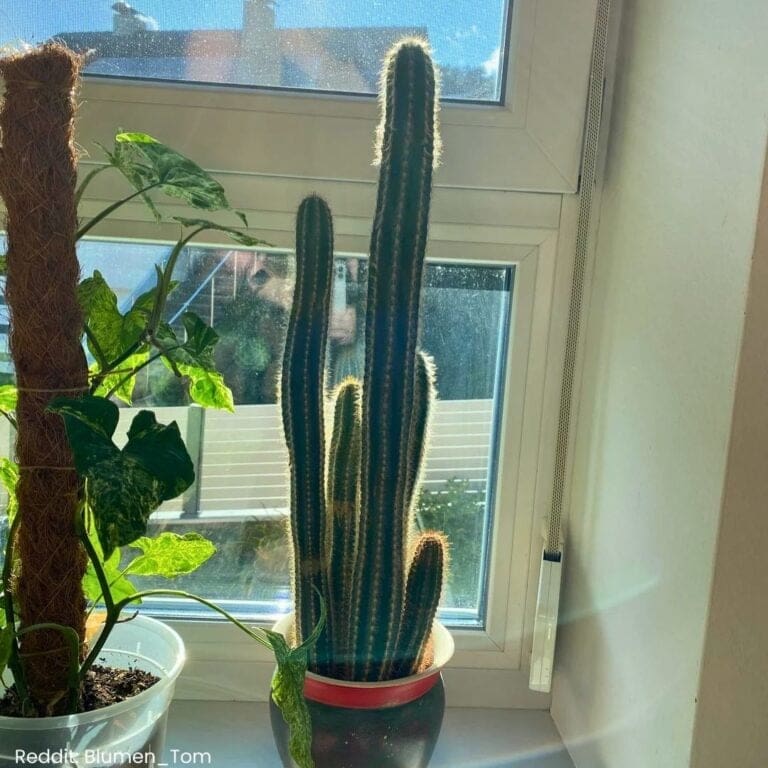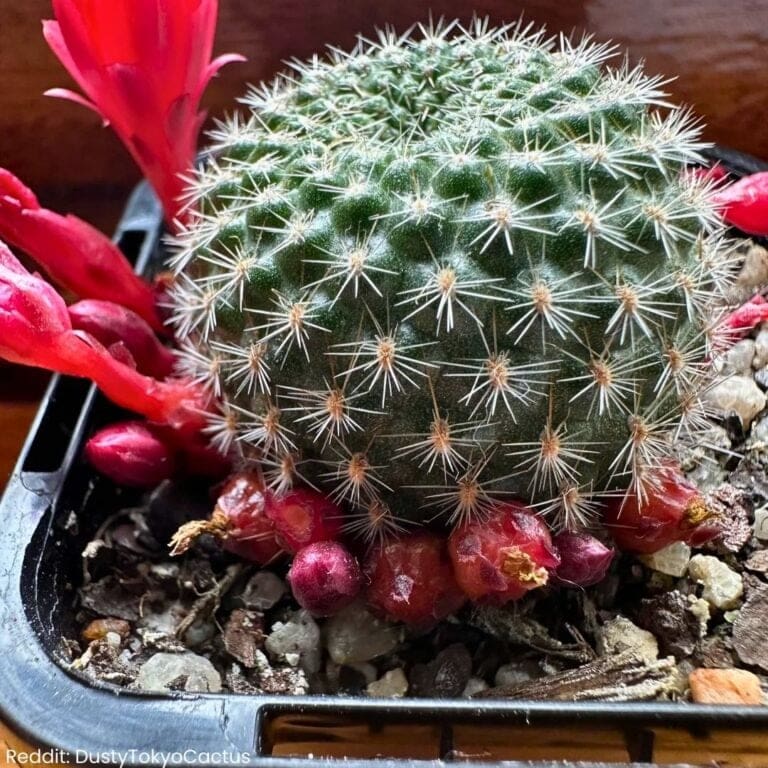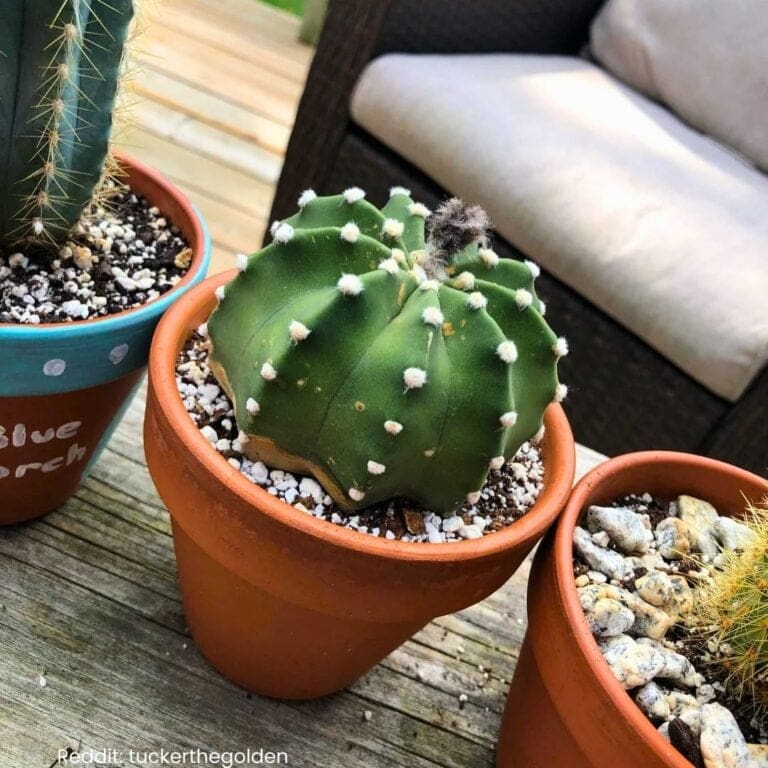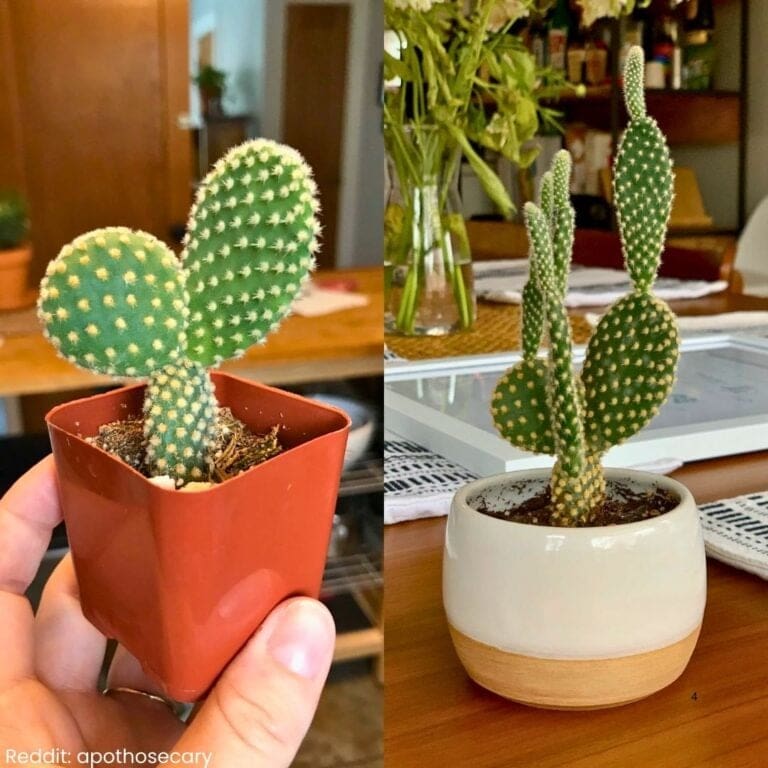Fern Leaf Cactus Care: Secrets to Thriving Indoor Greenery
Are you looking to spice up your indoor plant collection? Let me introduce you to the fern leaf cactus, a unique plant that’s easy to care for and great for any home.
You might have seen it with its long, trailing stems and leaves that resemble ferns. It’s a real showstopper! 🪴
Taking care of a fern leaf cactus isn’t as tricky as it seems. All it needs is bright, indirect light and occasional watering. Isn’t that amazing?
This plant adds a tropical vibe without demanding too much attention. It’s perfect for those who might not have a green thumb but still love having greenery around. 🌿
Do you want a plant that’s a little different but still low maintenance? The fern leaf cactus could be just the thing.
I know I love having one in my living room, and it’s always a conversation starter when friends visit. Are you curious yet? 😊
Please note: Simplify Plants is reader-supported. As an Amazon Associate, I earn from qualifying purchases made by our readers with no extra cost added to you all! Some links in the post are affiliate links and I get a commission from purchases made through links in the post.
Understanding the Fern Leaf Cactus
The fern leaf cactus is fascinating. It’s unique because of its long, trailing leaves that look a lot like ferns. Let’s explore what makes this plant special and where it comes from.
What Is a Fern Leaf Cactus?
A fern leaf cactus isn’t your typical cactus! 🌵 It’s known for its thick, leafy stems that resemble ferns.
These stems can grow quite long, making them perfect for hanging baskets. I love how the green leaves fill a room with life and charm.
Unlike regular cacti, it likes a bit more humidity and doesn’t need direct sunlight.
This makes it a great indoor plant for those of us who might not have the sunniest of windowsills.
Just imagine a gentle cascade of green over your favorite shelf. How cool is that?
Do you have a fern leaf cactus at home? If not, maybe it’s time to add some leafy goodness to your space!
Natural Habitat and History
The fern leaf cactus, or Epiphyllum anguliger, comes from the tropical forests of Mexico. It’s used to growing in warm, humid conditions.
In its natural habitat, it typically grows on trees, using its roots to cling to the bark.
What’s fascinating is its flowers. When it blooms, the cactus produces stunning white flowers, often at night.
Imagine the surprise of finding a beautiful bloom opening up as the stars come out. 🌟
Don’t worry, you won’t need to bring home a rainforest to keep your fern leaf cactus happy.
Just provide it with a bit of moisture and indirect light, and it will thrive in most homes.
Have you ever seen one of these flowers bloom at night? It’s such a magical sight! 🪴
Proper Lighting for Growth

The fern leaf cactus needs specific lighting to thrive. I’ll outline how to provide the best indoor and outdoor light so it can flourish like never before. 🌱
Indoor Lighting Conditions
I’ve found that bright, indirect light is ideal for indoor fern leaf cactus.
Too much direct sunlight can scorch the leaves, so placing it near a window with filtered light, like a sheer curtain, is perfect.
If you don’t have a window, consider using an LED grow light. They’re energy efficient and easy to find!
Keep an eye on the color of the leaves.
If they start turning yellow or pale, it might indicate too much sun. On the flip side, deep green means it is happy!
Tip: Who knew cactus could be so particular?
Try moving it around during the day or year, depending on the sun’s position.
Where do you usually keep your plants? 🌞
Outdoor Light Requirements
For outdoor growing, partial shade is where this cactus shines best.
If it’s summer, and the sun is blazing, consider putting it under the protection of a larger plant or a shady spot. Being exposed to full sun for long periods can be too intense.
Remember, even a cactus can get sunburned!
I usually check them out a few times a week to make sure they’re not showing stress signs like brown spots.
How do you ensure your plants get the right light outside? I’d love to know your favorite spots. 🌻
Watering Your Fern Leaf Cactus
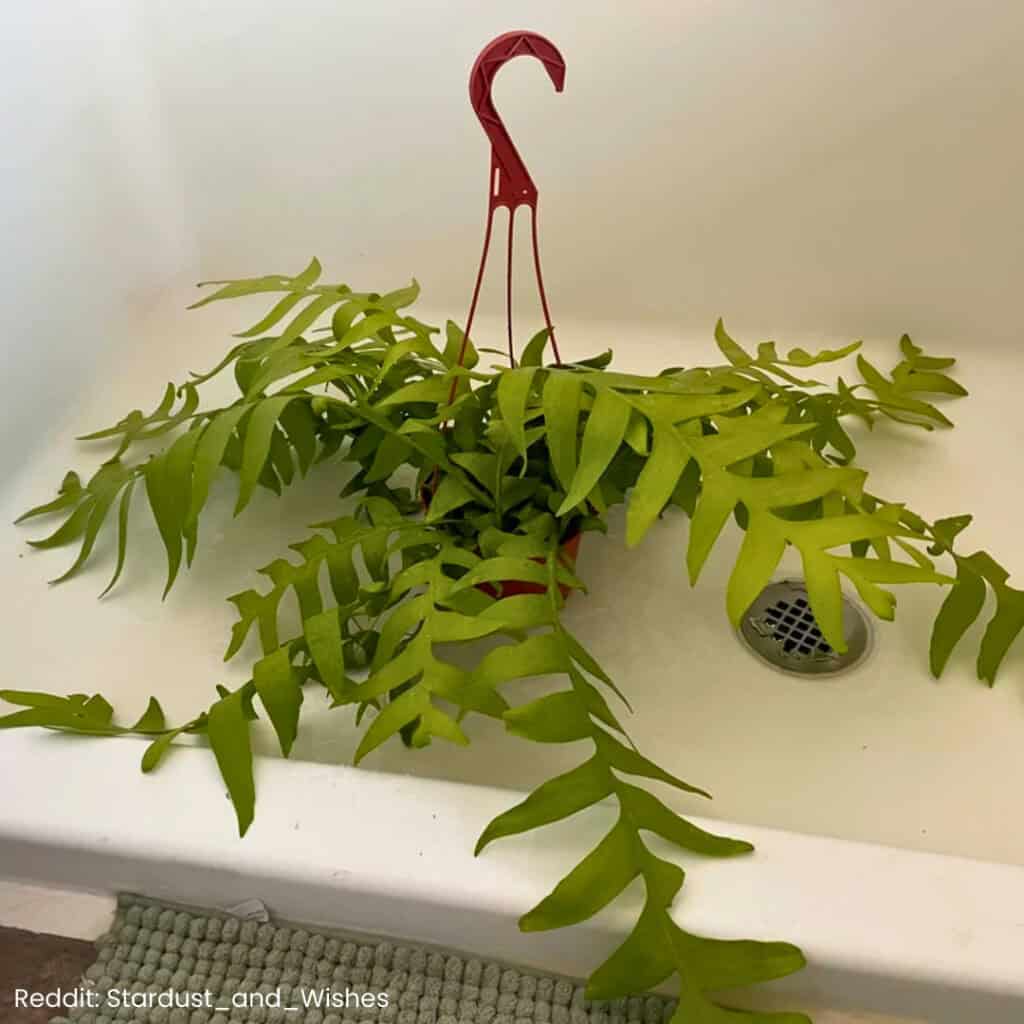
I’ve learned that watering a fern leaf cactus can be a bit different than other plants. It’s all about striking the right balance. Too much water? Not good. Too little? Also not good.
Let’s make sure we get it just right for our green friends!
Watering Frequency
I know how tempting it is to over-water plants, but with a fern leaf cactus, that’s a big mistake. 🪴
These guys prefer to dry out a bit between waterings. I usually let the top 1-2 inches of soil dry before giving it a drink.
Depending on your climate, this might mean watering every 1-2 weeks. 🌦
In winter, my cactus needs even less water because it’s not growing as much.
I make sure to use rainwater or distilled water, as tap water can have chemicals that might upset my cactus.
Remember, it’s not about sticking to a strict schedule but rather keeping an eye on how dry the soil gets.
Signs of Overwatering
I once learned the hard way that a soggy cactus is an unhappy cactus.
If my cactus’s leaves start to become soft or mushy, that’s my clue to cut back on water.
Overwatering can lead to root rot, and I certainly don’t want that! 🚫💧
Yellowing leaves can also be a sign of too much water.
If I see this, I let the cactus dry out completely before I water it again.
This keeps it healthy and thriving in my home.
So, if in doubt, I always check soil moisture, not just the calendar. 😅
Soil and Repotting Essentials

When it comes to caring for my fern leaf cactus, choosing the right soil and knowing how to repot it are crucial steps. Getting these two aspects right can make all the difference in keeping my cactus healthy and happy.
Ideal Soil Mixture
The perfect soil for my fern leaf cactus should be well-draining to prevent any soggy roots.
I like to use a mix of potting soil, orchid bark, and perlite. This blend allows for great drainage and enough air for the roots to breathe. 🌿
Sometimes, I add a bit of charcoal to help with moisture control. Balancing water retention and drainage means my cactus can thrive without drowning.
Keep in mind, using a cactus or succulent mix can be a convenient alternative too.
Have you tried using these mixes for your plants?
Repotting Procedures
I find that repotting every 2-3 years is just right for my cactus.
I always pick a pot that’s a little larger than the current one to give the roots more space to grow. 🌱 It’s essential that the pot has drainage holes.
First, I gently remove the cactus from its current pot, shaking off old soil from the roots.
While doing this, I check for any damaged roots and prune them if necessary.
Then, I place it in the new pot with fresh soil, ensuring it’s at the same soil level as before.
Finally, I water lightly, but not too much, to let the roots settle in their new home.
Do you enjoy repotting your plants too? It’s a little messy, but I find it pretty rewarding! 😊
Fertilization and Nutrients

Fertilizing a fern leaf cactus keeps it happy and thriving. It’s all about knowing when and how much to feed it, plus picking the right kind of fertilizer. Let’s jump in and keep our leafy buddy healthy! 🌿
When and How to Fertilize
Do you ever feel like your fern leaf cactus is asking for a little boost?
During the growing season, which is spring and summer, I feed mine about once a month. It’s like a little burst of energy! 💪
I use a balanced liquid fertilizer diluted to half strength. Too much, and it’s like trying to eat an entire pizza by myself—overwhelming!
During fall and winter, I let it rest. No extra food needed then; just good vibes. 😊
Mix the fertilizer into water and pour it gently into the soil. This ensures the roots get all those yummy nutrients they crave.
Always check the soil beforehand; it should be slightly damp to avoid burning those delicate roots.
Remember, it’s all about balance and timing!
Selecting the Right Fertilizer
Finding the right fertilizer is like finding the perfect pair of shoes. It needs to fit just right!
For my cactus, I prefer a balanced one, like 10-10-10. This gives equal parts nitrogen, phosphorus, and potassium.
If you’re feeling fancy, you can even use a cactus-specific fertilizer.
These formulas are like a tailored suit—made just for succulents and cacti.
They sometimes include extra micronutrients that help the cactus thrive. Just be careful not to overdo it!
Over-fertilizing is like drinking too much soda; it can damage our plant friend. 😬
What kind of fertilizers have you tried? Feel free to share your tips and tricks! 🪴
Temperature and Humidity Control

Caring for a fern leaf cactus involves monitoring both temperature and humidity. Keeping these conditions just right helps the plant thrive. Let’s explore what it really needs. 🌿😊
Appropriate Temperature Range
When it comes to temperature, fern leaf cacti prefer it warm and cozy.
I like to keep mine at around 60°F to 80°F (15°C to 27°C). It’s ideal for them, just like a sunny day is perfect for us.
Have you ever noticed how grumpy they get when it’s cold? ❄️
Avoid drafts or sudden changes in temperature.
I once forgot mine by an open window, and it wasn’t happy!
If you live in a cooler climate, consider keeping the cactus indoors during those chilly months. It’s like offering it a warm blanket.
Maintaining Ideal Humidity
Humidity is another factor I keep an eye on.
Fern leaf cacti like it a bit humid. Their sweet spot is around 50% to 60% humidity.
I use a humidity tray or a small humidifier nearby. It’s like giving them a mini spa treatment! 💧
In dry climates, you could mist the cactus lightly or keep it in rooms like the kitchen or bathroom, where humidity tends to be higher.
Just be careful not to overwater, as too much moisture can lead to trouble. 😅
Pruning and Maintenance
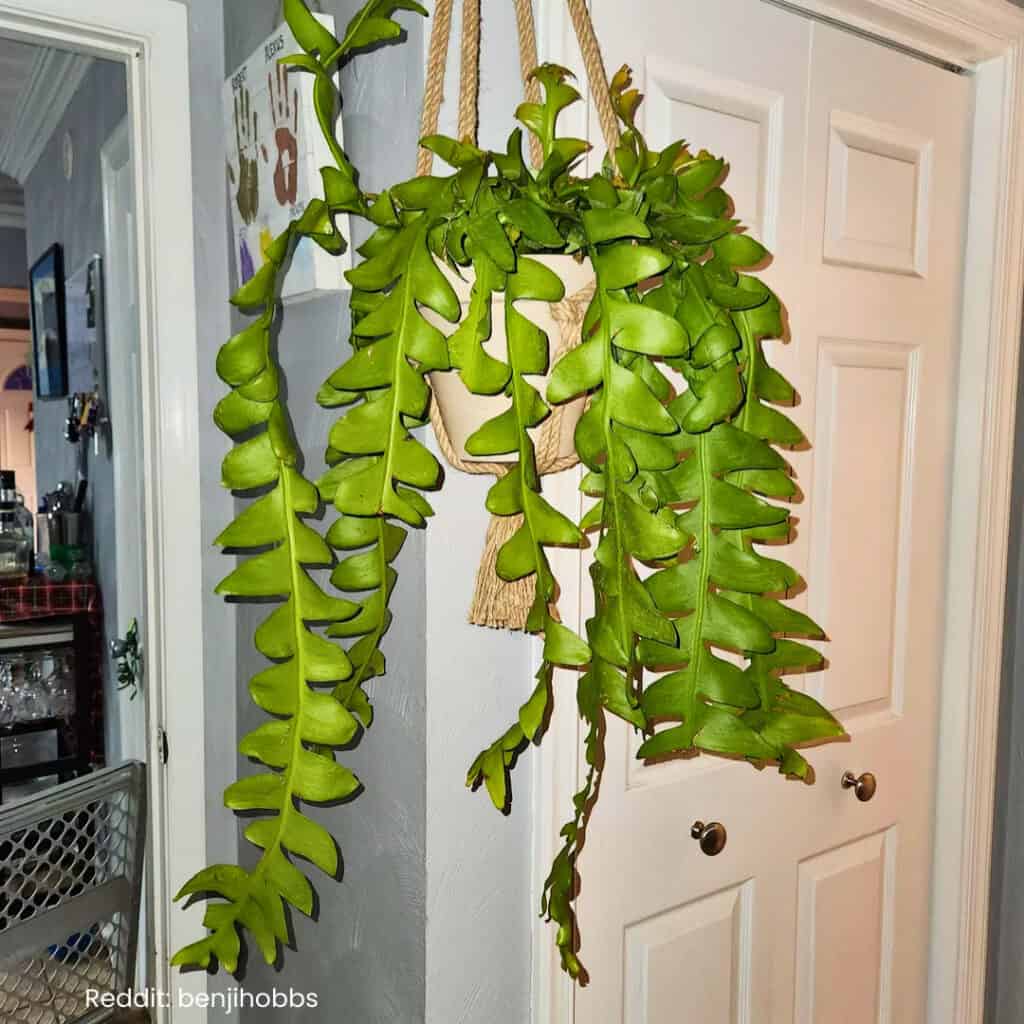
Pruning and maintenance are key to keeping your fern leaf cactus healthy and happy. I’ll share some simple pruning methods and essential upkeep tips to ensure your plant thrives. 🌿
Pruning Techniques
Pruning is an important step in keeping a fern leaf cactus in top shape.
I find it helpful to prune in the growing season, usually spring or early summer.
To start, I check for dead or damaged stems. Cutting these back helps focus the plant’s energy where it’s needed most.
I like to use sharp, clean pruning shears to avoid infection. When I cut, I make sure to trim right above the base of the stem.
Want your plant to look fuller? ✂️ I snip some of the healthy stems to encourage branching.
Don’t forget to wear gloves! Those edges can be prickly.
How’s your cactus looking these days? Is it time for a trim?
Regular Maintenance Tips
Keeping my fern leaf cactus healthy doesn’t just stop at pruning. Regular care keeps it happy and healthy.
First, ensure it’s in a bright spot, but not direct sunlight. 🌞
Watering is another key. I water when the top inch of soil is dry.
Feeding is also important. I use a balanced liquid fertilizer about once a month during the growing season.
I’m a bit of a neat freak, so I gently wipe the leaves to keep dust away.
Are you on top of your watering game?
How about feeding? Let me know your tips! 🪴
Propagation Methods

When it comes to growing more fern leaf cacti, there are a couple of easy ways: cutting propagation and seed propagation. Both methods can lead to new, healthy plants with just a bit of care and attention.🌿
Cutting Propagation
I find cutting propagation to be super fun and pretty straightforward! 😊
First, I take a healthy stem from an existing plant. It’s best to cut a 4- to 6-inch section using clean scissors or a knife.
Then, I let the cutting dry for a few hours or even overnight to form a callus. This helps prevent rotting when planted.
After that, it’s time to plant!
I place the cutting into a pot filled with well-draining soil. A cactus mix with some added perlite works well.
I water lightly and make sure the pot gets indirect light.
Before I know it, roots start forming.
Sometimes I even root it in water first, then transfer it to soil when roots are visible!
Seed Propagation
Starting a fern leaf cactus from seeds can be a bit more challenging, but it’s rewarding too! 😊
I usually start by getting seeds from a reliable source.
Soaking them in water for 12-24 hours helps soften the coat, making them ready for planting.
Next, I spread them evenly over moist, well-draining soil.
I cover them lightly with a thin soil layer and keep the soil damp.
Covering the pot with clear plastic helps trap humidity, acting like a mini greenhouse.
Seeds need warmth, so I put them in a bright spot, but not direct sunlight. ⛅
Once the seedlings pop up, I gradually remove the cover and let them grow a bit before transplanting them into individual pots.
Have you tried growing cacti from seeds before? 🌱
Troubleshooting Common Issues

Oh no, is your fern leaf cactus looking a bit off? Don’t worry, I’m here to help. From pests munching on leaves to diseases sneaking in, let’s tackle these pesky problems together.
Remember, a happy cactus is a healthy cactus! 🌵
Pest Problems and Solutions
Pesky little critters like mealybugs and spider mites can invade our fern leaf cactus. Ever notice tiny white fluff or webbing? That’s a clue!
First, gently wipe the leaves with a damp cloth to remove them.
For tougher pests, I mix a mild soap solution (a few drops of dish soap in water) and spray it on the affected areas.
Neem oil is another great alternative, but be careful not to overuse it.
Don’t forget to check under the leaves too!
For stubborn infestations, introducing natural predators like ladybugs might be effective.
Keep your cactus away from other plants while treating it.
Are we budding pest detectives yet? 🕵️♂️
Disease Prevention and Treatment
Diseases like root rot or leaf spot can cause trouble. Is your cactus looking droopy or spotted?
It might be getting too much water, which could lead to root rot. Make sure the soil dries out between waterings.
I always ensure my cactus pot has good drainage. If you suspect root rot, consider repotting with fresh soil.
Leaf spot is another issue where I spot yellow or brown patches on leaves.
I cut off the affected leaves and ensure better airflow around the plant by not crowding it with others.
If things get serious, a good fungicide can help.
Caring for plants is a bit like a mystery adventure, isn’t it? 🕵️♀️
Decorative Tips and Display Ideas
When it comes to showing off my fern leaf cactus, creativity is key! 🌿
Have you ever thought about using hanging baskets? They let the long stems dangle down beautifully.
Just imagine walking into a room and seeing those cascading vines. It’s like living in a green wonderland!
I also love placing my cactus on a bookshelf. It adds a touch of nature to my reading corner. 📚
But remember, books and water don’t mix well, so I always use a waterproof tray under the pot.
Do you have a favorite place for your cactus at home?
Want to add a pop of color? Try using bright pots! A bold red or yellow pot can turn my fern leaf cactus into a statement piece. 🌈
It feels like art without needing a paintbrush. What color would you pick?
Mixing my cactus with other plants can create an indoor jungle vibe. I group mine with ferns and succulents on a windowsill.
Different textures and colors make the display lively. Plus, it’s like having my own mini garden indoors.
Do you like grouping plants too?
Using macramé hangers is another fun idea. They’re trendy and make my cactus look chic.
Plus, it’s a great way to show off those impressive vines without needing a lot of floor space. Who doesn’t love a space-saving trick?
Hope you find these ideas as exciting as I do! 💡
Feel free to share your own tips; I’d love to hear them!
Frequently Asked Questions
I know caring for a fern leaf cactus can be a bit tricky at times. Let me help you navigate the essentials and tackle those common questions you might have 🌵.
How can I propagate a fern leaf cactus?
Propagating this cactus is quite simple! I snip a healthy leaf, let it dry for a day, and then plant it in soil.
After a few weeks, roots start to appear. It’s like magic!
Just keep the soil slightly damp, and your new plant is on its way to thriving.
What are the indoor care tips for a fern leaf cactus?
Keeping it indoors means finding a bright spot that’s free from direct sunlight.
I water mine when the topsoil is dry. A little humidity boost now and then also makes a big difference.
Try misting it or placing it near a humidifier.
Why are the leaves on my fern leaf cactus turning yellow?
Yellow leaves can be a sign of overwatering 😬.
I try to feel the soil first; if it’s wet, I pause the watering.
Sometimes, poor light or a shift in temperature can also cause this. Move it to a comfier spot with steady conditions.
Can a fern leaf cactus be grown outdoors, and if so, how?
Outdoor growing is possible in a warm climate.
I make sure the spot you choose is sheltered from strong winds and has some shade.
Regular watering is key, especially in dry times, but be careful not to drown it. Nature will do the rest.
How often should I water my fern leaf cactus?
I only water when the top inch of soil is dry to the touch.
Usually, that’s about once a week, but hotter days might need more.
It’s like having a pet that doesn’t need constant attention!
Just listen to your cactus’s needs, and it’ll be happy.
What conditions encourage a fern leaf cactus to flower?
For those beautiful blooms, I give it some indirect light and enough moisture.
A little fertilizer boost during the growing season can help too.
It’s rewarding to see them blossom after a bit of extra care and attention 🌼.
Recommended Garden Supplies
| Product Image | Our Recommended Gardening Supplies | Check Offers! |
|---|---|---|
Top Top
Top
Top
Top
Top
Top
Top
Top | rePotme Houseplant and Tropical Classic Potting Soil Mix | Check Offer On Amazon |
 Top
Top
Top
Top
Top
Top
Top
Top | Espoma Organic Indoor Plant Food | Check Offer On Amazon |
 Top
Top
Top
Top
Top
Top
Top
Top | GooingTop LED Grow Light 6000K Full Spectrum Clip Plant Growing Lamp | Check Offer On Amazon |
 Top
Top
Top
Top
Top
Top
Top
Top | Soil Moisture Meter | Check Offer On Amazon |
 Top
Top
Top
Top
Top
Top
Top
Top | Govee Hygrometer Thermometer, Bluetooth Enabled! | Check Offer On Amazon |
 Top
Top | LEVOIT Humidifiers for Large Room(Best For Plants) | Check Offer On Amazon |
 Top
Top
Top
Top
Top
Top
Top
Top | Upgraded DIY Automatic Drip Irrigation Kit, 15 Potted Houseplants Support | Check Offer On Amazon |
 Top
Top
Top
Top
Top
Top
Top
Top | Stainless Steel Heavy Duty Gardening Tool Set | Check Offer On Amazon |
 Top
Top
Top
Top
Top
Top
Top
Top | Bonide Insecticidal Soap | Check Offer On Amazon |
 Top
Top
Top
Top
Top
Top
Top
Top | Bonide 32 oz Spray Neem Oil for Organic Gardening | Check Offer On Amazon |
 Top
Top
Top
Top
Top
Top
Top
Top | Garden Safe Fungicide | Check Offer On Amazon |



